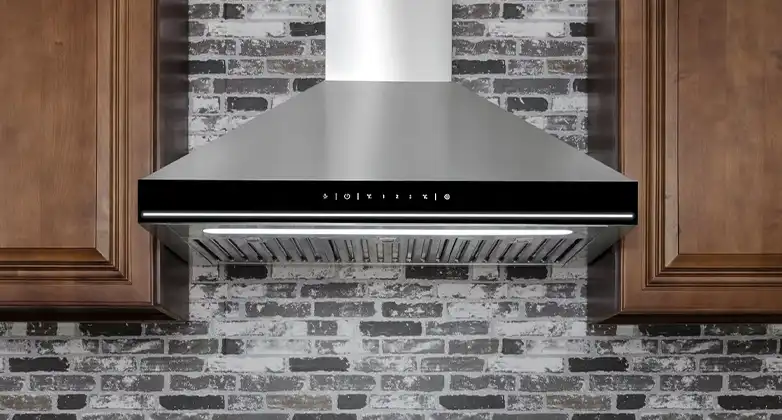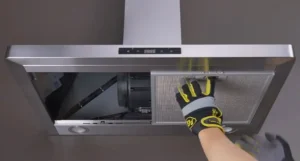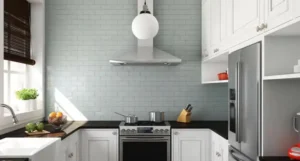A range hood is an essential appliance in your kitchen, responsible for venting smoke, odors, and cooking byproducts, while also providing lighting to your cooking area. Properly securing your range hood is crucial not only for functionality but also for safety. That’s because an insecure kitchen vent is a huge security risk.
Therefore, in this article, we will explain why you need to secure your range hood perfectly, how to do it in a proper manner, and how to maintain it to keep it well-secured for a long time. Let’s begin.

Why It’s Important to Secure Your Range Hood?
Securing your range hood is essential for several reasons:
Safety
A secure range hood minimizes the risk of accidents in your kitchen. Loose or improperly installed hoods can fall, causing damage or injury. Additionally, a secure installation reduces the chance of electrical or ventilation issues that could lead to fires or health hazards.
Efficiency
A well-secured range hood operates at its optimal efficiency. It effectively removes cooking fumes, smoke, and odors, improving the air quality in your kitchen and preventing grease buildup on surfaces.
Aesthetics
A properly secured range hood enhances the overall look of your kitchen. It appears seamless and complements the kitchen’s design, making it a focal point rather than an eyesore.
How to Secure Your Range Hood
Now that you know that you gotta do it, here’s how to go about it in a proper manner:
Read the Manual
Start by thoroughly reading the manufacturer’s installation and operating manual that accompanies your range hood. This document provides specific guidelines and instructions for your particular model.
Choose the Right Location
Selecting the correct location for your range hood is crucial for its effectiveness. It should be installed directly above the cooking surface to capture cooking byproducts effectively. The recommended height is typically 24 to 30 inches above the cooktop.
Pro Tip: If you have a high-output cooktop, consult the manufacturer’s guidelines to ensure the range hood can handle the heat and airflow requirements.
Check Electrical and Ventilation
Before installation, ensure you have proper access to electrical wiring and ventilation ducts. If you’re not comfortable working with these, consider hiring a professional electrician or HVAC technician.
Prepare the Area
Clear the installation area of any obstacles, such as cabinets or shelves. This ensures a smooth installation process and minimizes the risk of damage.
Mounting Bracket
Most range hoods come with a mounting bracket or plate. Follow the manufacturer’s instructions to attach this bracket securely to the wall or ceiling. Ensure that it’s anchored to a stud or an appropriate support structure.
Pro Tip: Use a stud finder to locate and mark the studs in your wall or ceiling before attaching the mounting bracket. This ensures a stable and secure installation.
Secure the Hood
Lift the range hood into place, aligning it with the mounting bracket. Secure the hood to the bracket using the screws or fasteners provided in the installation kit. Ensure it’s level and firmly in place.
Pro Tip: Have a helper assist you in holding the range hood while you secure it to the bracket to prevent any mishaps.
Electrical Connection
If your range hood has electrical components, such as lights or a fan, follow the manufacturer’s instructions to connect the electrical wiring. If you’re not experienced with electrical work, it’s safer to hire a qualified electrician for this step.
Pro Tip: Install a dedicated electrical circuit for the range hood to prevent overloading existing circuits.
Ventilation Duct
If your range hood is vented to the outside, you’ll need to connect the ventilation ductwork. This ensures that cooking fumes are effectively expelled outdoors. Use appropriate ducting materials and follow local building codes for duct size and material requirements.
Pro Tip: Insulate the duct to prevent condensation and improve energy efficiency.
Test and Adjust
Turn on the range hood to ensure it’s working correctly. Check for proper airflow and noise levels. Make any necessary adjustments to the fan speed and lighting.
Pro Tip: Regularly clean the fan blades and housing to maintain optimal airflow and noise reduction.
Secure Any Loose Parts
After installation, double-check all screws and connections to ensure they are tight. Loose parts can create vibrations and noise, affecting the hood’s performance.
Pro Tip: Apply thread-locking adhesive to screws and bolts to prevent them from loosening due to vibrations.
Maintenance Tips to Keep Your Range Hood Secure
Regular maintenance is essential to keep your range hood operating efficiently. Here are some maintenance tasks to consider:
Clean or Replace Filters
Grease filters should be cleaned or replaced regularly to maintain airflow and filtration efficiency.
Exterior Cleaning
Wipe down the exterior of the range hood to remove grease and dust.
Inspect for Wear and Damage
Periodically inspect the range hood for signs of wear or damage and address any issues promptly.
Pro Tip: Set a maintenance schedule to ensure you don’t overlook essential tasks.
Frequently Searched Questions (FAQ)
Can I install a range hood myself?
While some homeowners with experience in DIY projects may be able to install a range hood themselves, it’s essential to have the necessary skills and knowledge, particularly when dealing with electrical wiring and ventilation ducts. If you’re unsure, it’s safer to hire a professional.
How often should I clean or replace the filters in my range hood?
The frequency of filter maintenance depends on your cooking habits. In most cases, it’s recommended to clean or replace grease filters every 1-3 months. Consult your range hood’s manual for specific guidance.
Can I use an extension cord for the range hood?
It’s not advisable to use an extension cord for a range hood. Instead, have a dedicated electrical outlet installed near the hood’s location to avoid potential safety hazards.
What should I do if my range hood is making excessive noise?
Excessive noise can be caused by loose components, damaged fan blades, or a dirty fan housing. Check for loose screws and clean the fan housing. If the noise persists, consult the manufacturer’s troubleshooting guide or contact a technician.
Final Thoughts
Securing your range hood is essential for safety, efficiency, and the overall aesthetics of your kitchen. By following the steps outlined in this comprehensive guide, you can ensure your range hood is securely installed and properly maintained. Remember to consult the manufacturer’s instructions for your specific model and, when in doubt, seek professional assistance to guarantee a safe and effective installation.

![Read more about the article [Answered] Can You Use Semi Rigid Duct For Range Hood?](https://kitchenhoodcare.com/wp-content/uploads/2023/09/can-you-use-semi-rigid-duct-for-range-hood-300x161.webp)

